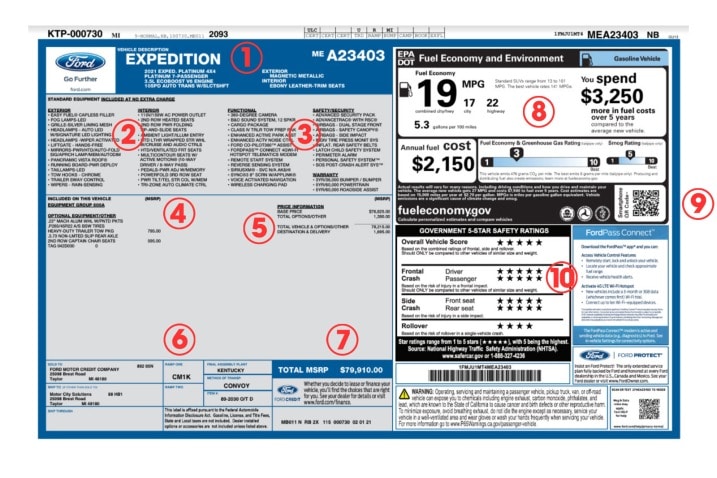Anyone who has shopped for a new car has looked at its window sticker — if for no other reason than to check the price. But the window sticker also offers other information that can be useful to buyers. This article will help you navigate the sea of text and numbers on a new car's window sticker. The sample sticker above comes from a 2021 Ford Expedition and highlights 10 key areas of interest. Keep in mind that the layout of a window sticker can change depending on the automaker, but the information on what the industry calls the Monroney label is required by law to be the same across manufacturers.
1. Model information
This is where you will find the basic model information for the vehicle. The section is usually located in the top left or right corner. It tells you the engine and transmission combination, exterior and interior color, the model year and trim level of the vehicle. Checking this part of the sticker is the best way to quickly ensure that the car in front of you has the engine and color configuration you're looking for.
2. Standard equipment
This section of the window sticker lists all items and features that are included in the manufacturer's suggested retail price (MSRP). Items listed here should be consistent with any other vehicle in this trim level. These items are grouped into such categories as Exterior, Interior, Safety/Security, Comfort/Convenience and Mechanical/Performance.
3. Warranty information
This section lists the length of the new car's bumper-to-bumper and powertrain warranties and notes any roadside assistance package that the manufacturer offers. Some new cars also come with free maintenance programs, and that coverage is also listed here. If you want to compare coverage among automakers, Edmunds keeps a comprehensive list on our warranty and roadside assistance page.
4. Optional equipment
In this section, you'll find information on the vehicle's factory-installed options. Some carmakers bundle them into packages. Others offer them à la carte. Knowing a vehicle's options can help you price it correctly and make apples-to-apples comparisons with other cars on the lot.
5. Pricing information
This is where you'll find the base price of the vehicle and a breakdown of options and fees. Other items that would appear here are the destination charge (cost of transporting the vehicle to the dealer) and any gas-guzzler tax (levied on cars with a combined mpg of 22.5 or less). The total price of the vehicle is sometimes located here, but it often occupies its own space.
6. Parts content information
Vehicle manufacturing is often a global process. In some cases, the engine production, transmission build and final assembly of the vehicle take place in different countries. The parts content section lists where the vehicle was assembled and often the percentage of U.S. and Canadian parts it contains. Our sample window sticker doesn't have the percentages, but many others do. For more information on this question, shoppers can turn to the National Highway Traffic Safety Administration (NHTSA) website, which has the percentage breakdown of domestic and foreign content in cars from 2007 to now.
7. Total price
This section shows the total MSRP of the vehicle. That doesn't mean you have to pay this price, but it does give you a point of reference for your negotiations. Use the Edmunds Suggested Price, found on our inventory pages, to help you determine a fair price. Depending on the demand for the car, sometimes this "sticker price" is a fair price.
8. Fuel economy label
The fuel economy label, also called an EPA label, gives you estimates of the vehicle's fuel efficiency. This block helps you compare the mpg numbers on one car versus another. The combined mpg number is the most prominent and most important figure to note.
9. QR code
Scanning this pixelated square with a smartphone camera will link you to the mobile EPA website. You can then customize your driving stats to get personalized fuel economy data. You can also compare the fuel economy to other vehicles you're interested in.
10. Safety ratings
The NHTSA tests a number of new vehicles every year and issues star ratings based on the results. This information is in the safety rating section of the window sticker. Occasionally, the Insurance Institute for Highway Safety (IIHS) scores also are displayed on the window sticker, as seen on our sample label. Because the NHTSA doesn't test every car on the market, the safety rating section will sometimes be blank. If this is the case, consumers can check the IIHS website.
Side note: supplemental window sticker
You won't always find this sticker on a new car, but if you do, pay attention. Dealers sometimes affix what's called a supplemental window sticker next to the actual window sticker and use it to list the dealer-added accessories that are on the car. Here are some tips on how to handle the dealer's new car add-ons, which you may or may not want to buy.
"Sticker is quicker"
We once heard a salesperson say this, referring to how much time could be saved if a customer would just pay the sticker price. We don't agree with that sentiment, but it's true that a new car's window sticker is the fastest way to verify the options on a vehicle so that you can accurately look up its market value.
Whether you're shopping in person or via the internet or phone, request a copy of the window sticker of a vehicle you are interested in. Once you have all the information a sticker contains, you can truly determine the best price to pay for a car that's right for you.

